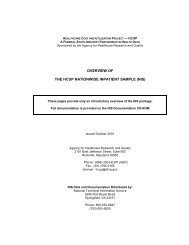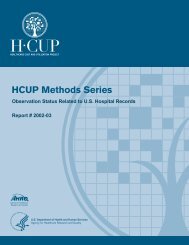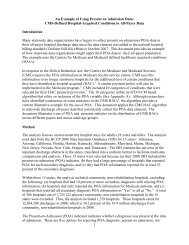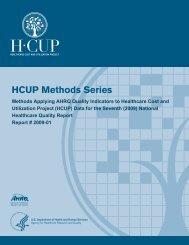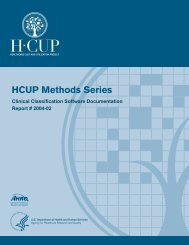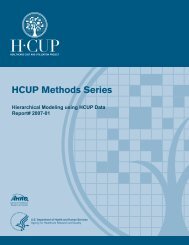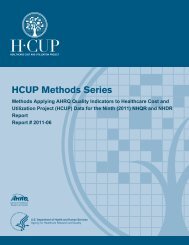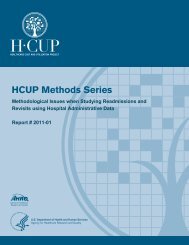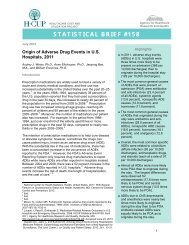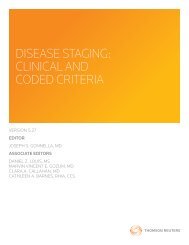Tools for More Accurate Inpatient Cost Estimates with HCUP ...
Tools for More Accurate Inpatient Cost Estimates with HCUP ...
Tools for More Accurate Inpatient Cost Estimates with HCUP ...
You also want an ePaper? Increase the reach of your titles
YUMPU automatically turns print PDFs into web optimized ePapers that Google loves.
EXECUTIVE SUMMARYBackgroundThe Agency <strong>for</strong> Healthcare Research and Quality (AHRQ) creates hospital-wide cost-to-chargeratios (CCR) <strong>for</strong> each hospital in the Healthcare <strong>Cost</strong> and Utilization Project (<strong>HCUP</strong>). Eachyear, the agency collects accounting data from the Centers <strong>for</strong> Medicare and Medicaid Services(CMS) and the American Hospital Association (AHA). There is a known problem <strong>with</strong> thehospital-wide CCR in that it does not account <strong>for</strong> variations among service departments in thehospital. In particular, we know that there is a higher markup (the inverse of CCR) <strong>for</strong> ancillaryservices as a whole than <strong>for</strong> routine bed-unit services.Previous studies examined 2003 and 2006 <strong>HCUP</strong> data <strong>for</strong> individual services and cost centersto develop cost estimates and adjustment factors (AFs) <strong>for</strong> each All Patient Refined-DiagnosisRelated Group (APR-DRG) and <strong>for</strong> each Clinical Classification Software (CCS) category. In thepresent study, we use 2009 data to develop a more extensive methodology. We create AFs <strong>for</strong>each Medicare-Diagnosis Related Group (MS-DRG) and <strong>for</strong> each CCS category. It is intendedthat users of <strong>HCUP</strong> databases can multiply the ordinary hospital-wide CCR by the appropriateAF <strong>for</strong> the patient’s MS-DRG or CCS category to get a more accurate CCR and, hence, a moreaccurate cost estimate.MethodThe data sources <strong>for</strong> this study were: (1) all states in the <strong>HCUP</strong> State <strong>Inpatient</strong> Databases (SID)<strong>for</strong> 2009 where hospitals reported detailed charges, (2) standard accounting reports publiclyreleased by CMS cost data <strong>for</strong> fiscal year 2009, and (3) <strong>HCUP</strong> Crosswalk data <strong>for</strong> hospitals in2009. Thirty-four states were included in the analyses. Among them, 27 states used thestandard UB04 revenue codes <strong>for</strong> detailed charges and seven states had bucketed charges thatcould be mapped to CMS cost-center clusters. For the great majority of hospitals and cases,the sum of the detailed charges was <strong>with</strong>in $300 of the reported total charges.For each hospital, 13 cost-center clusters were defined. The CCRs <strong>for</strong> the clusters werecalculated <strong>for</strong> services from the: routine bed unit, specialty care unit, sub-provider, nursery, sub-1



